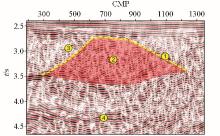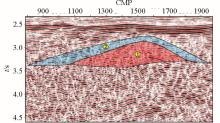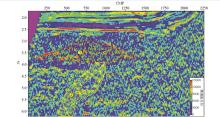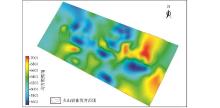|
|
|
| The application of low frequency seismic identification technology to deep Carboniferous volcanic rocks in Wulungu depression |
Hui ZHOU1, Yu-Kun TIAN1, Xiao LIU2( ), Juan LI1, Yan-Yan MA1 ), Juan LI1, Yan-Yan MA1 |
1. The Key Laboralory of Unconventional Petroleum Geology,CGS,Beijing 100083,China
2. Beijing Institute of Geological Survey,Beijing 102206,China |
|
|
|
|
Abstract The Carboniferous volcanic reservoir in Wulungu depression is an important target stratum for hydrocarbon exploration in Junggar Basin.However,due to its deep burial,complex lithology and strong late reformation,it is difficult to depict the distribution of volcanic rock masses by relying on the previous two-dimensional seismic exploration technology.Mainly based on the seismic data collected by low frequency vibroseis,the authors studied the distribution characteristics of Carboniferous volcanic rocks in the northern part of Wulungu depression.In view of the advantages of low-frequency information in deep-layer imaging and the good reflection of stacked section to structural trends,low-frequency stack section was used to identify wave field,which can guide migration section interpretation.Then by combining geological,seismic and drilling data,research on volcanic rock identification was carried out.The seismic response characteristics of volcanic facies in this area were summarized.The distribution of volcanic rocks was identified and characterized by means of seismic reflection characteristics and seismic attribute analysis.A low-frequency seismic identification method for volcanic reservoirs suitable for deep-buried complex lithologic conditions is explored.It provides a basis for Carboniferous oil and gas exploration in this area.
|
|
Received: 06 May 2019
Published: 28 November 2019
|
|
|
|
Corresponding Authors:
Xiao LIU
E-mail: sea_251@163.com
|
|
|
|

|
Structural location of the study area
|

|
Spectrum of new and old seismic profiles
a—previous seismic profiles;b—new seismic profiles;c—frequency spectrum contrast map of new and old profiles;d—location map of survey line
|

|
Frequency-division scanning stack profiles of low-frequency seismic exploration
a—2~4 Hz;b—4~8 Hz;c—8~15 Hz;d—15~30 Hz;e—30~60 Hz;f—50~100 Hz
|

|
Structural framework(4~15 Hz,stacked section)
①—envelope surface of rock mass;②—fault surface wav;③—sedimentary stratum;④—rotating wave
|

|
Structural interpretation profile(Post-stack time migration profile)
①—envelope surface of rock mass;②—faults;③—sedimentary strata of carboniferous;④—mesozoic bottom boundary
|

|
Logging curve cross plot
|

|
Seismic reflection characteristics of volcanic rocks
①—Strong impedance interface of volcanic rock mass contour;②—Chaotic reflections in volcanic rocks;③—angular unconformity between volcanic rock mass and surrounding rock;④—sedimentary rock strata
|

|
Seismic reflection characteristics of volcanic facies
①—volcanic sedimentary facies;②—overflow facies
|

|
Seismic attribute recognition of volcanic rock mass
①—volcanic rock mass;②—volcanic passage
|

|
Prediction of volcanic rock distribution range in research area
|
| [1] |
康玉柱 . 新疆两大盆地石炭—二叠系火山岩特征与油气[J]. 石油试验地质, 2008,30(4):321-327.
|
| [1] |
Kang Y Z . Characteristics of the Carboniferous-Permian volcanic rocks and hydrocarbon accumulations in two great basins,Xinjiang area[J]. Petroleum Geology & Experiment, 2008,30(4):321-327.
|
| [2] |
张朝军, 石昕, 吴晓智 , 等. 准噶尔盆地石炭系油气富集条件及有利勘探领域预测[J]. 中国石油勘探, 2005(1):11-15.
|
| [2] |
Zhang C J, Shi X, Wu X Z , et al. Carboniferous oil and gas abundance conditions and predicted favorable exploration fields in Junggar Basin[J]. China Petroleum Exploration, 2005(1):11-15.
|
| [3] |
张明洁, 杨品 . 准噶尔盆地石炭系(油)气藏特征及成藏条件分析[J]. 新疆石油学院学报, 2000,2(2):8-13.
|
| [3] |
Zhang M J, Yang P . The Characteristic and analysis of reservoir-forming conditions of the Carboniferous oil and gas Pools in Junggar Basin[J]. Journal of Xinjiang Petroleum Institute, 2000,2(2):8-13.
|
| [4] |
王淑芳, 邹才能, 侯连华 , 等. 准噶尔盆地东部石炭系火山岩气藏石油地质特征及有利勘探方向分析[J]. 地学前缘, 2013,20(2):226-236.
|
| [4] |
Wang S F, Zou C N, Hou L H , et al. Petroleum geological characteristics of gas accumulation in carboniferous volcanics and prospect for gas exploration,Eastern Junggar Basin[J]. Earth Science Frontiers, 2013,20(2):226-236.
|
| [5] |
王学斌, 赵淑娟, 李三忠 , 等. 准噶尔盆地东北缘乌伦古坳陷中生代逆冲推覆构造[J]. 大地构造与成矿学, 2014,38(1):62-70.
|
| [5] |
Wang X B, Zhao S J, Li S Z , et al. Mesozoic Thrust and Nappe structures in the Wulungu depression of the Northeastern Junggar Basin[J]. Geotectonica et Metallogenia, 2014,38(1):62-70.
|
| [6] |
陈占坤, 谢国军, 张福顺 . 准噶尔盆地乌伦古坳陷石油地质特征及勘探方向[J]. 新疆地质, 2010,28(1):61-64.
|
| [6] |
Chen Z K, Xie G J, Zhang F S . Petroleum geologic characteristics and exploration strategy in Wulungu depression of Junggar Basin[J]. Xinjiang Geology, 2010,28(1):61-64.
|
| [7] |
杨朝, 赵淑娟, 李三忠 , 等. 准噶尔盆地东北缘乌伦古坳陷油气成藏的构造制约[J]. 地质科学, 2015,50(2):516-522.
|
| [7] |
Yang Z, Zhao S J, Li S Z , et al. Structural constrain to hydrocarbon accumulation in the Wulungu depression of the Junggar Basin[J]. Chinese Journal of Geophysics, 2015,50(2):516-522.
|
| [8] |
谭绍泉 . 乌伦古坳陷石炭系地层特征与勘探方向[J]. 石油天然气学报, 2012,34(4):65-68,77.
|
| [8] |
Tan S Q. Carboniferous formation characteristics and exploration direction for Wulungu depression[J]. Journal of Oil and Gas Technology, 2012, 34(4): 65-68,77.
|
| [9] |
余淳梅, 郑建平, 唐勇 , 等. 准噶尔盆地五彩湾凹陷基底火山岩储集性能及影响因素[J]. 地球科学—中国地质大学学报, 2004,29(3):303-308.
|
| [9] |
Yu C M, Zheng J P, Tang Y , et al. Reservoir properties and effect factors on volcanic rocks of basement beneath Wucaiwan depression,Junggar Basin[J]. Earth Science—Journal of China University of Geosciences, 2004,29(3):303-308.
|
| [10] |
张年富, 曹耀华, 况军 , 等. 准噶尔盆地腹部石炭系火山岩风化壳模式[J]. 新疆石油地质, 1998,19(6):450-453.
|
| [10] |
Zhang N F, Cao Y H, Kuang J , et al. Weathering crust model of Carboniferous volcanic rock in hinterland of Junggar Basin[J]. Xinjiang Petroleum Geology, 1998,19(6):450-453.
|
| [11] |
靳军, 张朝军, 刘洛夫 , 等. 准噶尔盆地石炭系构造沉积环境与生烃潜力[J]. 新疆石油地质, 2009,30(2):211-214.
|
| [11] |
Jin J, Zhang C J, Liu L F , et al. Structural/Sedimentary environment and hydrocarbon-generating potentials of Carboniferous in Junggar Basin[J]. Xinjiang Petroleum Geology, 2009,30(2):211-214.
|
| [12] |
唐勇, 王刚, 郑孟林 , 等. 新疆北部石炭纪盆地构造演化与油气成藏[J]. 地学前缘, 2015,22(3):241-253.
|
| [12] |
Tang Y, Wang G, Zheng M L , et al. Carboniferous basin evolution and its hydrocarbon accumulation in the north of Xinjiang[J]. Earth Science Froutiers, 2015,22(3):241-253.
|
| [13] |
陈鹏, 于常青, 韩建光 , 等. 低频可控震源在哈拉湖冻土区二维地震勘探试验研究[J]. 地球物理学进展, 2018,33(2):562-570.
|
| [13] |
Chen P, Yu C Q, Han J G , et al. Low-frequency vibroseis experimental study of 2D seismic exploration for Hala lake's permafrost region[J]. Progress in Geophysics(in Chinese), 2018,33(2):562-570.
|
| [14] |
杨平, 高国成, 侯艳 , 等. 针对陆上深层目标的地震资料采集技术——以塔里木盆地深层勘探为例[J]. 中国石油勘探, 2016,21(1):61-74.
|
| [14] |
Yang P, Gao G C, Hou Y , et al. Seismic acquisition techniques for onshore deep targets: a case study of deep formations in Tarim Basin[J]. China Petroleum Exploration, 2016,21(1):61-74.
|
| [15] |
孙龙德, 方朝亮, 撒利明 , 等. 地球物理技术在深层油气勘探中的创新与展望[J]. 石油勘探与开发, 2015,42(4):414-424.
|
| [15] |
Sun L D, Fang C L, Sa L M , et al. Innovation and prospect of geophysical technology in the exploration of deep oil and gas[J]. Petroleum Exploration and Development, 2015,42(4):414-424.
|
| [16] |
王维红, 林春华, 张振 . 保幅低频面波压制方法与应用[J]. 地球物理学进展, 2015,30(3):1190-1194.
|
| [16] |
Wang W H, Lin C H, Zhang Z . Amplitude preserved low frequency surface wave suppression and its application[J]. Progress in Geophysics (in Chinese), 2015,30(3):1190-1194.
|
| [17] |
王永生, 胡杰, 张静 . 宽频勘探技术在柴北缘深层侏罗系勘探中的应用[J]. 岩性油气藏, 2017,29(6):101-107.
|
| [17] |
Wang Y S, Hu J, Zhang J , et al. Wide-frequency prospecting technology and its application on deep-seated Jurassic exploration in northern margin of Qaidam Basin[J]. Lithologic Reservoirs, 2017,29(6):101-107.
|
| [18] |
公亭, 王兆磊, 顾小弟 , 等. 宽频地震资料处理配套技术[J]. 石油地球物理勘探, 2016,51(3):457-466.
|
| [18] |
Gong T, Wang Z L, Gu X D , et al. Broadband seismic data matching processing[J]. OGP, 2016,51(3):457-466.
|
| [19] |
王璞君, 冯志强 , 等. 盆地火山岩(岩性·岩相·储层·气藏·勘探)[M]. 北京: 科学出版社, 2007.
|
| [19] |
Wang P J, Feng Z Q , et al. Basin volcanic rocks (lithology,lithofacies,reservoir,gas reservoir,exploration)[M]. BeiJing: Science Press, 2007.
|
| [20] |
姚新玉, 何正怀, 吴建华 . 准噶尔盆地火山岩地震相及分布特征[J]. 新疆石油地质, 1994,15(3):214-219.
|
| [20] |
Yao X Y, He Z H, Wu J H . Seismic facies and distribution characteristics of volcanic rocks in Junggar Basin[J]. Xinjiang Petroleum Geology, 1994,15(3):214-219.
|
| [21] |
孙国强, 赵竞雪, 纪宏涛 , 等. 准噶尔盆地陆西地区石炭系火山岩岩相[J]. 天然气工业, 2010,30(2):16-20.
|
| [21] |
Sun G Q, Zhao J X, Ji H T , et al. Lithofacies of Carboniferous volcanic rocks in the Luxi area,Junggar Basin[J]. Natural Gas Industry, 2010,30(2):16-20.
|
| [22] |
王洛, 李江海, 师永民 , 等. 准噶尔盆地滴西地区石炭系火山岩识别与预测[J]. 岩石学报, 2010,26(1):242-254.
|
| [22] |
Wang L, Li J H, Shi Y M , et al. The identification and prediction of Carboniferous volcanic rocks in Dixi area,Junggar Basin[J]. Acta Petrologica Sinica, 2010,26(1):242-254.
|
| [23] |
胡金祥, 李宗杰, 张永升 , 等. 准噶尔盆地东缘火山岩综合地球物理勘探[J]. 新疆地质, 2013,31(1):107-112.
|
| [23] |
Hu J X, Li Z J, Zhang Y S , et al. The integrated geophysical exploration for the northeast edge volcanic rock in Junggar Basin[J]. Xinjiang Geology, 2013,31(1):107-112.
|
| [24] |
秦志军, 魏璞, 张顺存 , 等. 滴西—五彩湾地区石炭系火山岩岩相特征研究[J]. 西南大学学报:自然科学版, 2016,38(5):9-21.
|
| [24] |
Qin Z J, Wei P, Zhang S C , et al. The lithofacies of Carboniferous volcanic rocks in Dixi Wucaiwan Area[J]. Journal of Southwest Petroleum University:Science & Technology Edition, 2016,38(5):9-21.
|
| [25] |
王伟锋, 高斌, 卫平生 , 等. 火山岩油气藏地球物理预测技术及准噶尔勘探实例[J]. 中国石油大学学报:自然科学版, 2012,36(6):33-39.
|
| [25] |
Wang W F, Gao B, Wei P S , et al. Geophysical prediction technologies for volcanic reservoirs and exploration case in Junggar Basin[J]. Journal of China University of Petroleum, 2012,36(6):33-39.
|
| [26] |
徐颖新, 尚华, 李秀珍 , 等. 火山岩地震解释技术在松辽盆地长岭断陷深层天然气勘探中的应用[J]. 石油地球物理勘探, 2008,43(s1):63-68.
|
| [26] |
Xu Y X, Shang H, Li X Z , et al. Application of volcanic rock seismic interpretation technique to deep natural gas exploration in Changling fault depression of Songl iao basin[J]. OGP, 2008,43(s1):63-68.
|
| [27] |
李明, 邹才能, 刘晓 . 松辽盆地北部深层火山岩气藏识别与预测技术[J]. 石油地球物理勘探, 2002,37(5):477-484.
|
| [27] |
Li M, Zou C N, Liu X . Identifying and predicting technology of deep volcanics gas reservoir in north of Songliao basin[J]. OGP, 2002,37(5):477-484.
|
| [28] |
伍菁华, 黄芸, 张继武 , 等. 火山岩相地震识别方法在准噶尔盆地东部的应用[J]. 天然气工业, 2007,27(s1):481-482.
|
| [28] |
Wu J H, Huang Y, Zhang J W , et al. The application of volcanic lithofacies seismic recognition method in eastern Junggar Basin[J]. Natural Gas Industry, 2007,27(s1):481-482.
|
| [29] |
Simm R, Bacon M . 地震振幅解释与应用[M]// 高建虎,等译.石油工业出版社, 2015.
|
| [29] |
Simm R, Bacon M. Seismic amplitude:An interpreter's Handook[M] //Gao J H,et al Tran. Petroleum Industry Press, 2015.
|
| [30] |
唐华风, 王璞珺, 姜传金 , 等. 波形分类方法在松辽盆地火山岩相识别中的应用[J]. 石油地球物理勘探, 2007,42(4):440-444.
|
| [30] |
Tang H F, Wang P J, Jiang C J , et al. Application of waveform classification to identify volcanic facies in Songliao basin[J]. OGP, 2007,42(4):440-444.
|
| [31] |
曾忠, 阎世信, 魏修成 , 等. 地震属性解释技术的研究及确定性分析[J]. 天然气工业, 2006,26(3):41-43.
|
| [31] |
Zeng Z, Yan S X, Wei X C , et al. Study of seismic attribute interpretation technologies and deterministic analysis[J]. Natural Gas Industry, 2006,26(3):41-43.
|
| [1] |
Yu-Fei FAN, Bao-Zhi PAN, Fang ZHANG. Research on conductive mechanism and saturation model of the volcanic reservoir with complex pore structure[J]. Geophysical and Geochemical Exploration, 2018, 42(1): 172-177. |
| [2] |
MENG Fan-Xing, HE Hai-Yang, LIANG Yong-Shun, CHEN Peng, WU Xu-Liang, SHAN Ya. The application of comprehensive geophysical prospecting method to the exploration of the volcanic rock type uranium deposits in Wuliying area[J]. Geophysical and Geochemical Exploration, 2017, 41(5): 826-834. |
|
|
|
|

